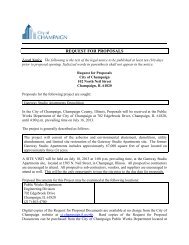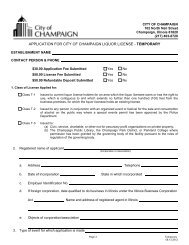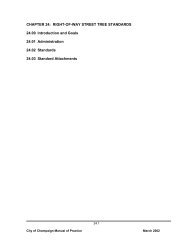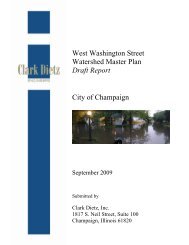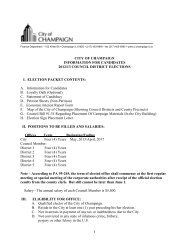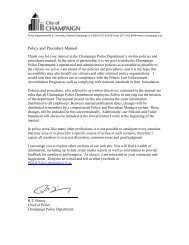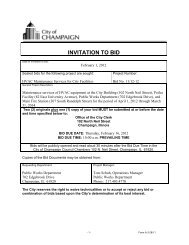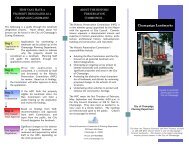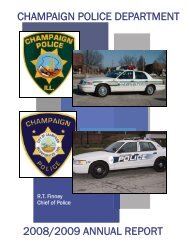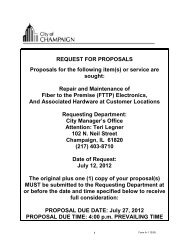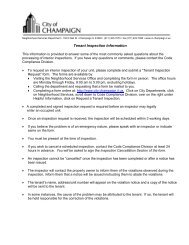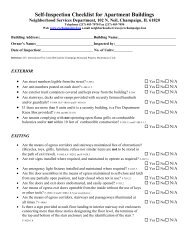2010-2014 Consolidated Plan - City of Champaign
2010-2014 Consolidated Plan - City of Champaign
2010-2014 Consolidated Plan - City of Champaign
You also want an ePaper? Increase the reach of your titles
YUMPU automatically turns print PDFs into web optimized ePapers that Google loves.
Needs <strong>of</strong> Small Related Homeowners (less than four members)There are approximately 12,000 small related families in the <strong>City</strong> <strong>of</strong> <strong>Champaign</strong>, <strong>of</strong> which 5,699 are below80% <strong>of</strong> the Median Family Income level. About 4,000 <strong>of</strong> those are low-income homeowners. More than40% <strong>of</strong> extremely low-income homeowners report some type <strong>of</strong> housing problem.Needs <strong>of</strong> Large Related Homeowners (five or more members)There are approximately 700 large related families in the <strong>City</strong> <strong>of</strong> <strong>Champaign</strong>, <strong>of</strong> which 34 percent reportsome type <strong>of</strong> housing problem.All Other (Non-Elderly)Of the 2,901 households in this category, approximately 24 percent are extremely low-income, with morethan half reporting some type <strong>of</strong> housing problem.Minority HouseholdsAccording to the 2000 data, extremely low-income Hispanic, and black non-Hispanic households areexperiencing housing problems to a greater extent than white non-Hispanic households. The datafluctuates among the different racial/ethnic groups as incomes increase. Elderly black non-Hispanichomeowners and non-elderly Hispanic homeowners with incomes less than 30% MFI indicate a 100%occurrence <strong>of</strong> housing problems.HUD considers racial groups to have a disproportionate housing need if their incidence <strong>of</strong> housingproblems is 10% higher than the percentage <strong>of</strong> persons in the income category as a whole. Based onthe information in the previous tables, Hispanic owners with incomes below 30% MFI and blackhomeowners with incomes between 30-50% MFI have disproportionate housing needs.A fairly recent occurrence which impacts the housing market is the rise <strong>of</strong> immigration. There are 14,389persons who were born outside <strong>of</strong> the United States living in <strong>Champaign</strong> County according to 2000Census, <strong>of</strong> which 6,564 settled after 1995. The rising number <strong>of</strong> immigrants in <strong>Champaign</strong> County shouldbe considered in planning to meet both current and future housing needs. The decade from 1990-2000saw the largest increase in the local immigrant population, with numbers rising each year. From 1990 to2000, while the population <strong>of</strong> the <strong>City</strong> <strong>of</strong> <strong>Champaign</strong> increased by 6%, the Asian population living in the<strong>City</strong> grew by 77%. The number <strong>of</strong> individuals defining themselves as Hispanic also increased significantlyin 2000. However, due to the revised definition <strong>of</strong> Hispanic used in the 2000 Census, it is impossible todetermine the exact increase by comparing to prior Census figures.Demand for the <strong>City</strong>’s housing rehab programs has historically been high among black, non-Hispanicowners and very low among Hispanic and Asian owners. Over the last four years, the <strong>City</strong>’s housingrehab assistance programs served households representing 45% white, 53% black, and 2% other. Much<strong>of</strong> the reason for this disproportionate demand from black homeowners may be due to the fact thatminority applicants are denied for private home improvement financing at higher rates than non-minorityapplicants, regardless <strong>of</strong> income. In a study conducted by a University <strong>of</strong> Illinois graduate student in2004 using Home Mortgage Disclosure Act (HMDA 2001) data for <strong>Champaign</strong>-Urbana as well as the <strong>City</strong><strong>of</strong> <strong>Champaign</strong> Analysis <strong>of</strong> Impediments to Fair Housing (2007), minority applicants for home purchaseand home improvement loans were shown to have higher denial rates than non-minority borrowers. Thispattern exists among all income groups. For all racial groups, credit history is the number one reason fordenial <strong>of</strong> home improvement loans.This data highlights the need for continued scrutiny <strong>of</strong> local lending methods, and a more proactiveinvestigation <strong>of</strong> fair housing practices. High rates <strong>of</strong> denial for poor credit indicate that there isinsufficient effort being made to educate the public about the importance <strong>of</strong> debt management.Needs Assessment: Housing and Homelessness 25



